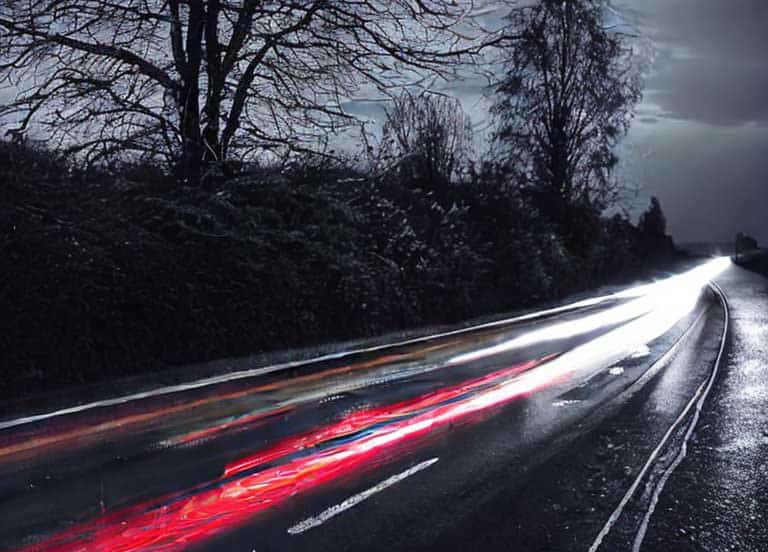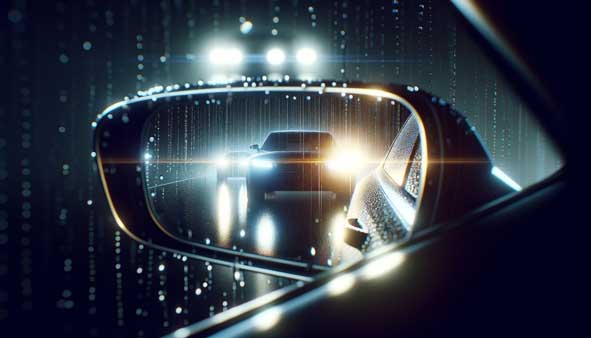Imagine driving at night and almost immediately, you’ll probably be thinking of the glare of oncoming headlights, or those in your rear view mirrors, and being dazzled by lights, particularly in wet weather.
Whether or not you enjoy driving at night, there are certain things you can watch out for to make your journey safer and make you a better driver at night. A lot of these relate to proper use of headlights and mirrors to both avoid dazzling drivers, and reduce glare for yourself.
Use the following links to jump to the section you’re interested in, or simply continue reading:
- Using Headlights for Safe Night-time Driving
- Tips for Safe Night Driving on Country Lanes
- Tackling Bends at Night
- Night Time Driving Distance
- Animals and Obstacles in the Road
- Overcoming Night Driving Distractions for a Safer Journey
- Avoid Being Dazzled by Oncoming Headlights
- How to Avoid Glare From Headlights of an Approaching Car
- How can you avoid dazzling lights from drivers behind you at night?
- When should you use dipped headlights?

How can you avoid dazzling lights from drivers behind you at night?
There are several useful and easy techniques to help make sure drivers behind you don’t dazzle you at night. This can be an especially difficult issue if the other drivers forget to dip their headlights or have them adjusted incorrectly.
- Adjust your rear-view mirror – First, make sure you adjust your rearview mirror properly. Most mirrors come with a switch or lever that allows you to change the angle, which helps to cut down on glare from the headlights of cars behind you. Try switching to the “night” setting or giving the mirror a slight tilt, which will keep the glare at bay without sacrificing visibility.

- Make sure side mirrors are set correctly – Next, pay attention to your side mirrors. Take the time to adjust them correctly, minimizing glare while still maintaining a clear view of the vehicles behind you. The idea is to position them in such a way that you can see the road behind you without having to crane your neck too much.
- Keep your windows clean – Lastly, it’s crucial to keep your windows clean, as dirty windows can scatter light and increase glare. Make it a habit to regularly clean both the inside and outside of your windows, which will not only ensure better visibility but also minimize reflections from the headlights of other vehicles.
When should you use dipped headlights?
Dipped headlights are designed to provide enough light for safe driving without causing unnecessary glare to others, making them an essential tool for night-time driving. Using dipped headlights correctly is crucial for safe night driving and ensuring that other drivers are not temporarily blinded by your lights. As examples, you should use dipped headlights at the following times:
- In Traffic or Built-Up Areas: When driving in areas with oncoming traffic or when you are following another vehicle closely enough that a full beam would dazzle them in their rear view mirrors, always use dipped headlights. This helps to avoid dazzling other drivers while still providing adequate illumination for you to see the road.
- During Dusk and Dawn: As visibility decreases during these times, it’s essential to switch your lights on and to use dipped headlights to make your vehicle more visible to other drivers and road users and to see the road better. Even if it’s not fully dark, dipped headlights improve safety.
- In Poor Weather Conditions: When driving in rain, fog, or snow, use your dipped headlights to improve visibility, as they reduce glare. Fog lights can also be used in dense fog or heavy rain, but always remember to switch them off when visibility improves.
- On Well-Lit Roads: On roads with good street lighting, dipped headlights are sufficient to see the road clearly without causing glare to other road users.
- Approaching Junctions or Pedestrian Crossings: Use dipped headlights to avoid dazzling pedestrians or other drivers waiting to cross or join the road.
Using Headlights for Safe Night time Driving
A key aspect of night time driving is the effective use of headlights and knowing exactly how to use them both for your own use and to be considerate towards other drivers and road users.
Turning on headlights at dusk is essential, as visibility decreases when daylight fades. Even if there is still some light outside, putting on your headlights will make your vehicle more visible to other drivers and help you see the road better.If you have automatic headlights, make sure that these are switched to automatic, rather than manual, and they will then come on in low light conditions, such as dusk or in heavily overcast weather conditions and sudden thunder storms.
If there is oncoming traffic or you are following another vehicle closely, it is crucial to use dipped headlights to avoid dazzling other drivers, as these provide enough illumination without causing excessive glare.
Use of full beam, on the other hand, is best on open roads with limited traffic or when you need to see further ahead, such as on rural roads. When using full beam, be mindful of other drivers; switch back to dipped headlights when you encounter oncoming traffic or when you’re approaching a vehicle from behind to prevent momentarily blinding the other driver. It is also important to use dipped headlights when in a built up area with street lights and if there are pedestrians or cyclists travelling towards you.
Dirty, foggy, or improperly aimed headlights can reduce visibility and make it difficult for you to see the road, so regularly clean your headlights and check their alignment to ensure they are working optimally. You can consult your operator’s handbook for your car to show how to test for properly adjusted beams and this can be measured against a wall or garage door.
One other consideration, which can often catch people out, is that when carrying a heavy load in your vehicle, your headlights may point upward more than normal, potentially dazzling other drivers. Once again, you can consult your vehicle’s manual for instructions on how to adjust your headlights in such situations to maintain proper alignment and avoid causing discomfort to others on the road.
Having headlights that are too bright, can cause unnecessary glare and dazzle other drivers. In fact, with the advent of more powerful, modern LED headlights, this has become such a problem that in 2024 the government decided to set up an independent study into headlight glare.
Tips for Safe Night Driving on Country Lanes
Driving at night on country lanes can be daunting with narrow roads, limited visibility, and the potential for unexpected obstacles. Many people will avoid country lanes when driving at night, for just these reasons.
Country lanes can be narrow, winding, and often have no street lighting. Reducing your speed gives you more time to react to potential hazards, such as sharp turns, potholes, or animals on the road.
Using your headlights effectively is also essential for maintaining visibility and ensuring the safety of other road users. Use dipped headlights when driving on country lanes and there is oncoming traffic or you are following another vehicle, to avoid dazzling other drivers or pedestrians. Switch to full beam when there is no oncoming traffic or when you need to see further ahead, but be sure to remember to switch back to dipped lights when you encounter other vehicles. This is a common issue, as you’ll often have to dip your beam and go back to full beam given the nature of the driving.
Avoid switching back to main beam as a driver passes you, as this can blast them with your main beam unintentionally. Watch for people flashing you, which is a sure sign you’ve forgotten to switch your beam down. Most dashboards have a bright blue light showing for when the beam is up, but check yours before you start a journey, if you’re unsure, so that you familiarise yourself with your car’s dashboard lights.
Tackling Bends at Night
When navigating country lanes, be cautious at bends, slowing down when approaching blind bends -sharp bends and those that curve to the left, so you have less of a view around the corner – and be prepared for the possibility of oncoming traffic, pedestrians, cyclists, or animals in the middle of the road. Watching for warning signs, such as those indicating sharp bends, junctions, or animal crossings can help you anticipate potential hazards ahead. Remember to keep your speed to one which allows you to react to obstacles you will encounter.
Night Time Driving Distance
Increasing your following distance by using the two second rule gives you more time to react to the actions of other drivers or obstacles in the road can make a significant difference in your safety. Look for reflective markers and cat’s eyes, which can help guide you along the road in areas with limited visibility.
Animals and Obstacles in the Road
Being aware of animals is crucial when driving on country lanes at night, as animals such as deer, foxes, and rabbits are more active during this time and may suddenly appear on the road. Be prepared to slow down or stop if you see an animal on or near the road. It can also be difficult to see people, who may often wear darker clothes in poor conditions and only show up as you get closer to them, so be aware of potential issues such as someone walking in the road or crossing it.
Remember, to be courteous to other drivers and if you encounter oncoming traffic on a narrow lane, slow down or pull over to a safe spot, if possible, to allow the other vehicle to pass. There are often wider areas on country lanes, so called ‘passing places’, that are there to allow vehicles to pass safely, so if you are at one of these when there’s someone approaching in the other direction it is polite for you to stop at this point. This not only ensures your safety but also fosters a sense of mutual respect and cooperation among road users.
Overcoming Night Driving Distractions for a Safer Journey
Impaired night time driving
First, a quick note on being your best and most alert self when driving! It should go without saying not to drive after drinking or taking any other substance or medicine that makes you drowsy or less capable of driving or reacting to issues and these are more likely to be used in the evening. The same is true if you have had an anaesthetic treatment after an operation, so check your doctor’s advice before driving. Sometimes, being intoxicated not only slows your reactions but also makes you feel more confident and therefore drive with less care. This is not a good combination and should be avoided.
Being tired while driving at night
Probably one of the most important issues to cover after intoxication is being sleepy while driving. Fatigue is a major contributing factor to driving accidents, especially at night. Drowsiness can impair your reaction time, judgment, and concentration. If you feel tired, take a break or find a safe place to pull over and rest before continuing your journey.
Ensure that you are well-rested before driving at night time. If you feel tired, take a break or find a safe place to pull over and rest before continuing your journey.
Keep your eyes on the road
Being tired at night means you can be more easily distracted. Adjusting vehicle controls, such as climate controls, radio stations, phone controls or GPS devices, can take your eyes off the road, so familiarize yourself with your vehicle’s controls and use voice commands or steering wheel controls when possible to minimize distractions.
Lighting a cigarette, smoking, or dealing with ashtrays can also divert your attention from driving safely. Avoid smoking while driving, especially at night. Remember, it takes a second to have an accident – while you’re looking away from the road, obstacles can suddenly present themselves and not paying attention to road conditions is often a key element in accidents.
Other distractions
Interior lighting, such as a bright dashboard lights and displays can cause glare on the windscreen and reduce your night vision. Dimming your dashboard lights to an appropriate level can help minimize distractions, help with driver fatigue and improve visibility.
Mobile devices are another significant source of distraction while driving, especially at night. The bright screens can further reduce your night vision, making it more challenging to see the road ahead. Avoid having anyone next to you texting, browsing, or making calls and of course, don’t use your own phone while driving. If passengers are being distracting, ask them to be considerate of the challenges of driving at night and minimize distractions.
External lights from oncoming traffic can be dazzling and cause temporary impaired vision, so stay focused on the road ahead and avoid staring directly at any bright light sources, particularly oncoming vehicles.
Being a better at driving at night
The first thing to do is to familiarize yourself with your vehicle’s controls and features, such as headlights, fog lights, and dashboard dimmer switches. Knowing how to quickly and effectively adjust these settings can help you adapt to changing conditions and minimize distractions while driving at night. Dim your dashboard lights to reduce glare, avoid using your mobile phone while driving, and encourage passengers to maintain a quiet environment, allowing you to concentrate on the road.
Practice proper headlight usage, using dipped headlights when you’re in traffic or following another vehicle closely to avoid blinding other drivers. Switch to full beam when there is no oncoming traffic or when you need to see farther ahead. Remember to switch back to dipped headlights when you encounter other vehicles to prevent causing discomfort or temporary blindness.
Keep your windshield and windows clean, as dirty glass can increase glare and reduce visibility. Clean both the inside and outside of your windows regularly. Internally, if a windscreen is dirty, it will more easily mist up in cold conditions, so this is really important for you to keep it clean.
Watch your speed
Adjust your driving speed to suit night time conditions. Slower speeds give you more time to react to potential hazards, such as animals, pedestrians, or sharp turns. Be especially cautious on unfamiliar roads or in areas with limited visibility. At night, it can be more challenging to judge distance and speed accurately. Increasing the space between your car and the one ahead gives you more time to react if the leading vehicle suddenly stops or slows down.
Develop good scanning techniques to stay aware of your surroundings and keep alert; scanning the road ahead, checking your mirrors frequently and look for any potential hazards.
Be extra cautious at junctions and look twice for other vehicles or pedestrians, as they can be more difficult to see at night.
Avoid Being Dazzled by Oncoming Headlights
Bright lights from other vehicles can be blinding, with the glare making it difficult to see the road ahead and there are some tips for dealing with oncoming headlights.
As a vehicle approaches from the opposite direction, instead of staring directly at the oncoming vehicle, focus your gaze on the left side of the road, such as the white edge line or the verge. This will help you maintain a sense of your position on the road without being dazzled. If you’re having trouble seeing due to oncoming headlights, reduce your speed to give yourself more time to react to any potential hazards.
If your rear-view mirror has a night setting, use it to reduce glare from headlights behind you. This feature usually involves flipping a small lever or pressing a button, depending on your vehicle’s design and if you’re unsure, check your car’s manual. This is a great technique to avoid getting overwhelmed by lights from behind which can be particularly distracting.
How to Avoid Glare From Headlights of an Approaching Car
Glaring lights from oncoming traffic are a particular issue for drivers. It makes it more difficult to drive, to assess the oncoming dangers and make it more wearing to drive. This is particularly the case during overcast weather, thunderstorms, rain showers or snow and when driving during twilight or at night. The following are some tips on how to avoid glare from headlights of an approaching car.
Ensure Your Windscreen is Clean and well maintained
A clean windshield is crucial for reducing glare. Ensure both the inside and outside are clean to prevent light from scattering.
To reduce glare caused from the outside of the windscreen:
- Make sure you keep the windscreen clear from dirt, as this can cause smearing where dirt dries It can also prevent water from being pushed off from the windscreen by your wipers, causing smears. A smeared windscreen can increase the glare from oncoming lights, as the water or dirt scatters the light.
- Keep your windscreen wipers maintained – a worn windscreen wiper blade will not clear water and dirt properly, as it will not make contact evenly. This can allow water to smear, leave water on the screen and increase glare from oncoming vehicles.
- Make sure your windscreen washer is full, and in winter that you have a suitable cold weather ‘anti-freeze’ product in it to prevent it from freezing and not being available when you need it most. Winter driving at night or in poor light conditions, or driving in wet conditions can need a screen wash while you are driving. So, keeping your windscreen wiper fluid topped up correctly can make your journey much safer and help to reduce glare from headlights.
To reduce glare on the inside of your windscreen:
- Dirt and grease will affect visibility through the windscreen. Grease comes from people wiping the windscreen with their hands or using dirty tissues for the same. Dirt comes from the air and sticks when vents are used, especially in dusty or wet conditions.
- In cold conditions, your windscreen can mist up, or even get wet on the inside when you wipe it, so you get added glare from oncoming lights and reflections from drivers behind you. Grease can cause smears which also scatter the light, even in the summer.
- To solve this, make sure you regularly clean the inside of your windscreen with a clean, lint free cloth and non-smearing cleaner that will properly remove dirt. This will also help reduce misting up in the first place, as water will be less likely to condense on clean glass.
Other tips to avoid the glare from oncoming headlights
- Look Towards The Left of Your lane: In the UK, you should direct your gaze to the left edge of your lane, to avoid the direct glare of oncoming headlights. It can be tempting to look full on at the lights, but this will leave you dazzled, and then less able to see in the darkness afterwards, so make sure you keep your eyes away from the lights.
- Blink if Necessary: If an oncoming vehicle’s headlights temporarily blind you, blinking rapidly can help your eyes readjust to the darkness quicker.
- If someone has full beam on: You can give a quick, momentary flash of your headlights to let them know. It can happen to anyone to forget they have a full beam on and this is common practice to warn others. Just don’t keep your beam on full because they did it to you. Remember, if you do flash, make it brief so you don’t dazzle them in turn.
- Adjust Your Driving Position: Adjusting your seat for a better driving position can help minimise the glare from oncoming traffic.
- Use Anti-reflective Glasses: If you still have difficulty at night, you might consider using anti-glare driving glasses, which have polarized lenses that can help reduce glare from oncoming headlights. However, they may not be suitable for all drivers, so consult with an optician before using them.
- Get Your Eyes Tested Regularly: It is also important to make sure to have your eyes examined regularly, as vision problems can exacerbate glare sensitivity.
- Dim Your Dashboard Lights: Dimming the dashboard lights can help your eyes adjust better to the darkness outside, improving your ability to deal with glare from oncoming traffic. It also improves your night time driving visibility generally
- Keep Your Headlights Clean and Properly Adjusted: Clean and properly aligned headlights not only improve your visibility but also ensure that you do not unduly contribute to the glare that oncoming drivers experience.
We hope the above helps you to drive more comfortably and in a safer way at night. If you need help with night time driving, and wish to have one to one help on how to be a better night time driver, this can be covered in our driving lessons or you can take one of our driving refresher courses and our instructors can take you through the techniques to make you a better and more confident at night.
Last updated: 28/06/2024

